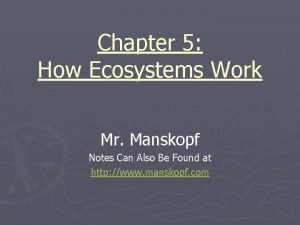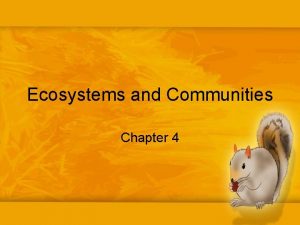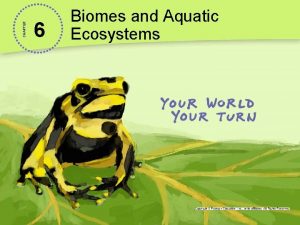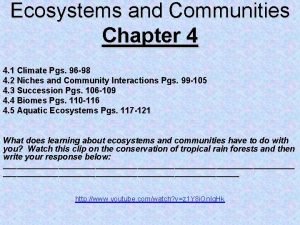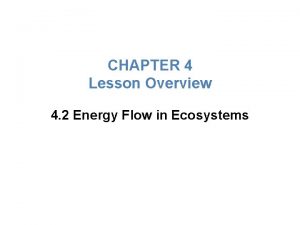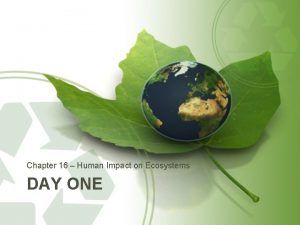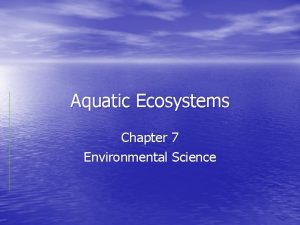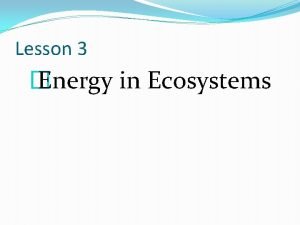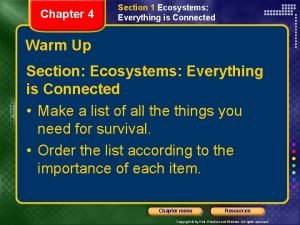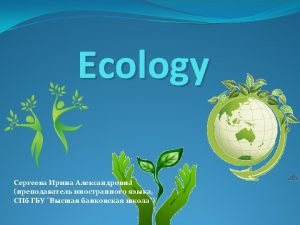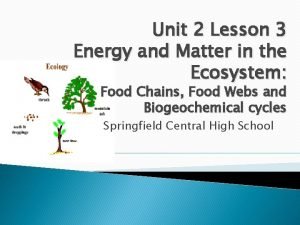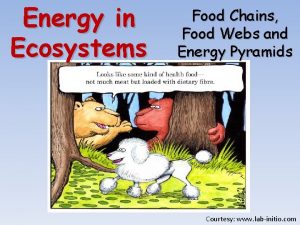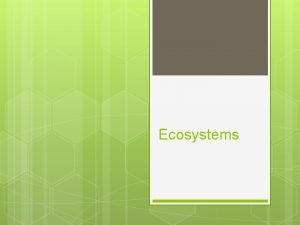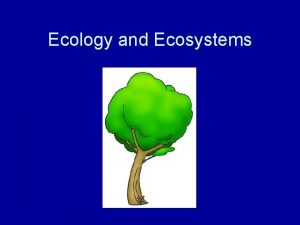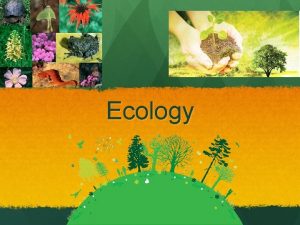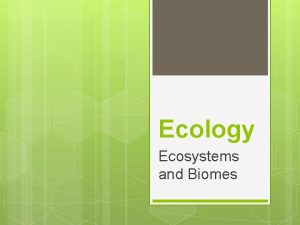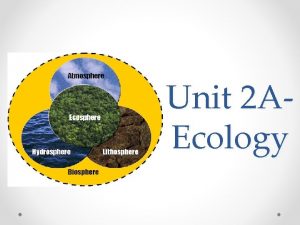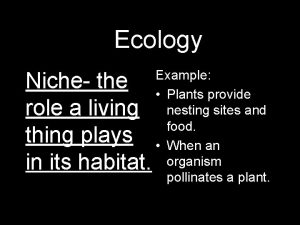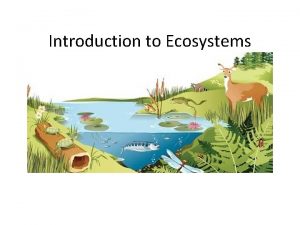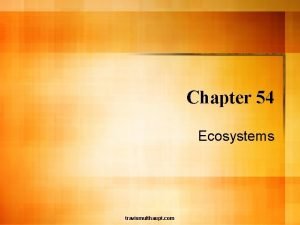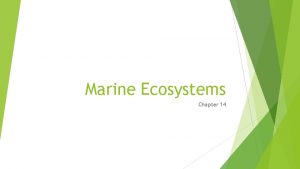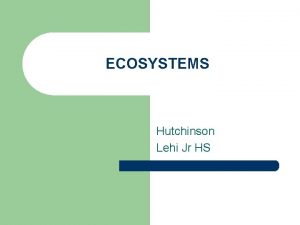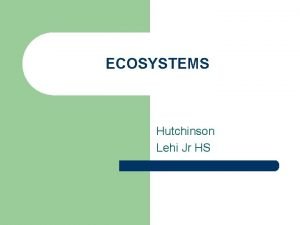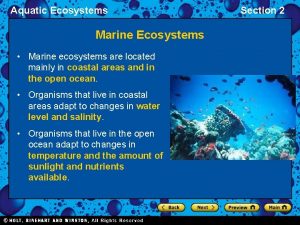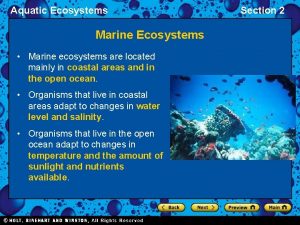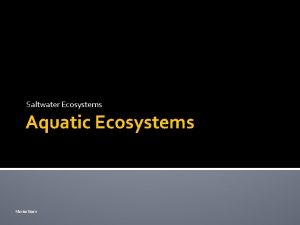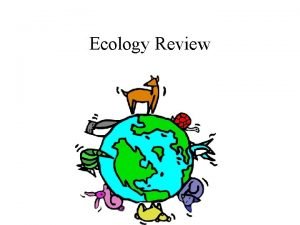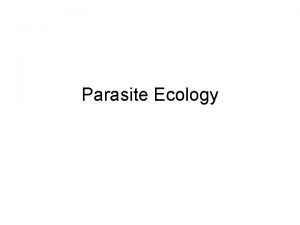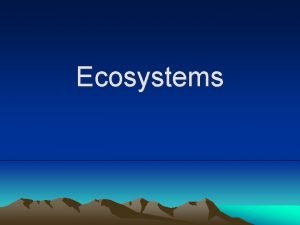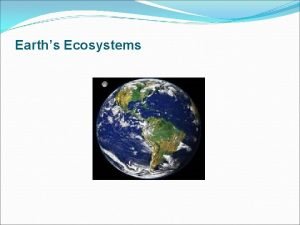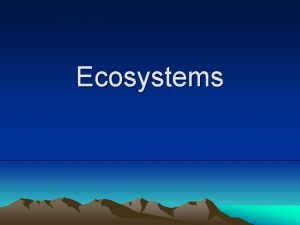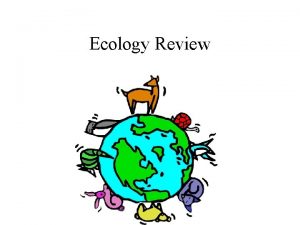CHAPTER 16 AECOLOGY AND ECOSYSTEMS ECOLOGY Ecology study

























- Slides: 25

CHAPTER 16 AECOLOGY AND ECOSYSTEMS

ECOLOGY • Ecology- study of organisms & their environment • 3 relationships: – How organisms (all living things) affect each other – How nonliving factors in an area affect organisms – How organisms affect nonliving factors in an area

Levels of organization

ECOSYSTEMS • Limited area in which living & nonliving things interact – Ecosystem – Example: Meadow, forest, city, mountain, lake, river, grassland, ocean, snowy mountains/plains, desert, tundra, savannah, tropical rainforest, • 2 major parts: – Abiotic Environment • physical environment, all nonliving factors – Biotic Community • all living organisms in an ecosystem

ECOSYSTEMS • Example: • Pond / Lake – Abiotic Environment? – Biotic Community?

ECOSYSTEMS • Area where an organism lives– Habitat – Good living conditions for an organism – Has what the organism needs (usually food, water, oxygen, shelter) • What an organism does (job)– Niche – Woodpecker- eats insects, adds dead trees to environment (food for insects), food for hawks, food for lice, puts holes in trees

Organism: Fish Habitat: Lake Habitat = Lake Ecosystem + Nonliving factors Organism: Other Fish Habitat: Lake


CHAPTER 16 BTHE ABIOTIC ENVIRONMENT

ABIOTIC FACTORS • Most have 5: – Light (sunlight) – Temperature – Water – Soil & Substrate / Rocks, stones – Wind / Current

ABIOTIC FACTORS • Light (sunlight): – Amount of light changes what plants live there – More plants = More animals = More ‘life’ / food – How long it has light, how bright it is

ABIOTIC FACTORS • Temperature: – Some bacteria grow in hot places, but not cold – Some animals can survive in cold, but not hot – Some animals can survive in hot, but not cold

ABIOTIC FACTORS • Water– Main difference – Deserts could be rainforests if they had more rain • Also, aquatic ecosystems – LARGE amounts of water – Ponds, streams, rivers, oceans, lakes…. • More water -> More plants -> More animal -> More ‘food’

ABIOTIC FACTORS • Soil and Substrate – Not all soil is the same • Some have lots of nutrients, some have little – Under soil is substrate- rock, clay, or both • Substrate adds nutrients to the soil • Example: Soil is really filled with nutrients -> More plants -> More animal -> More ‘food’

ABIOTIC FACTORS • Wind – Wind can make it hard for some organisms to survive – Also mixes gases and moves oxygen & carbon dioxide – Helps spores/seeds/pollen to spread (Plants reproduce) • Current – “Wind” in the ocean – Can affect temperature, oxygen levels, and nutrients (ocean/aquatic habitat)

THE WATER CYCLE • Continuous movement of water – Water Cycle • Evaporation – Movement of water from earth to atmosphere • Precipitation – Movement of water from atmosphere to earth

THE WATER CYCLE

CHAPTER 16 CTHE BIOTIC COMMUNITY

LEVELS OF ORGANIZATION 1. Individual- most basic level 2. Population- individuals from the same species 3. Community- all populations in one area 4. Ecosystem – a large area where all living and non-living interact

POPULATION TYPES • Producers (Autotrophs) – Make their own food by photosynthesis – Green plants, algae • Consumers (Heterotrophs) – Cannot make their own food -> get food from other sources – By hunting, gathering, collecting – Deer, rabbit, human

PRACTICE What are the abiotic and biotic factors? Biotic 1. All Plants 2. All Animals 3. Insects Abiotic 1. Rock 2. Soil, water, air 3. Sunlight 4. Dead tree log 5. Temperature

CHAPTER 16 DRHYTHMS IN THE ECOSYSTEM

CIRCADIAN RHYTHMS • Circadian Rhythms (“Internal clock”) – Daily rhythm; change takes place during one 24 -hour day • Example: – Owls / Bats / Cats come out only at night (active at night) • Nocturnal – Deer come out only during the day (active at day) • Diurnal

SEASONAL RHYTHMS • Seasonal Rhythm (or annual rhythm) – Change that occurs with the change of a season (usually 1 time per year) • Some places: -20°C at coldest, and 40°C at hottest!! – Organisms must be able to survive in both

SEASONAL RHYTHMS • To survive temperature changes, what can animals do? – Hibernate – Sleep – Migrate (Birds)
 Phosphorus cycle pearson education
Phosphorus cycle pearson education Chapter 55 ecosystems and restoration ecology
Chapter 55 ecosystems and restoration ecology Chapter 5 how ecosystems work study guide
Chapter 5 how ecosystems work study guide Study guide chapter 3 section 1 community ecology
Study guide chapter 3 section 1 community ecology Chapter 4 ecosystems and communities
Chapter 4 ecosystems and communities Chapter 6 biomes and aquatic ecosystems
Chapter 6 biomes and aquatic ecosystems 6 biomes and aquatic ecosystems
6 biomes and aquatic ecosystems Chapter 42 ecosystems and energy
Chapter 42 ecosystems and energy Chapter 3 lesson 3 biomes and aquatic ecosystems
Chapter 3 lesson 3 biomes and aquatic ecosystems Parasitism examples
Parasitism examples Transitional aquatic ecosystems
Transitional aquatic ecosystems Chapter 4 lesson 2 energy flow in ecosystems
Chapter 4 lesson 2 energy flow in ecosystems Chapter 16: human impact on ecosystems answer key
Chapter 16: human impact on ecosystems answer key Chapter 7 environmental science
Chapter 7 environmental science Energy in ecosystems lesson 3 answer key
Energy in ecosystems lesson 3 answer key Chapter 7 aquatic ecosystems test answers
Chapter 7 aquatic ecosystems test answers Chapter 16 human impact on ecosystems
Chapter 16 human impact on ecosystems Section 1 ecosystems everything is connected
Section 1 ecosystems everything is connected Which of the following tells you population density
Which of the following tells you population density Chapter 4 section 1 population dynamics answer key
Chapter 4 section 1 population dynamics answer key Ecology study guide answers
Ecology study guide answers Ecology is the study that helps to preserve
Ecology is the study that helps to preserve Frog life cycle
Frog life cycle Energy flow trophic levels
Energy flow trophic levels Phosphorus cycle
Phosphorus cycle Lab food chains and energy in ecosystems
Lab food chains and energy in ecosystems


